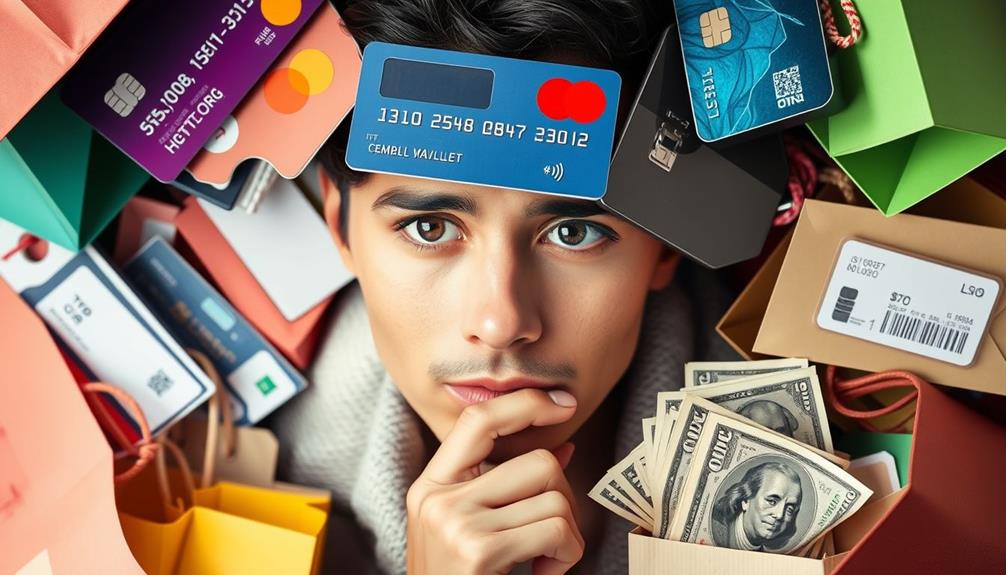The psychology of pricing deeply impacts your buying habits, often without your awareness. Higher prices can make products seem more valuable, drawing you in. Tactics like charm pricing—where prices end in .99—can trigger impulse purchases, while the fear of missing out compels quicker decisions. You may also notice that unique pricing structures cater to different budgets, enhancing perceived value. Additionally, clear communication about pricing changes fosters trust, making you more likely to return. Understanding these nuances can reshape how you perceive value and spend your money, revealing even more insights about why you buy what you buy.
Key Takeaways
- Pricing influences perceived value; higher prices often signal quality, making products more attractive to consumers.
- Emotional triggers, such as FOMO, drive impulsive purchases and override rational decision-making.
- Charm pricing (ending prices in .99) exploits psychological biases, increasing sales significantly.
- Transparent communication about pricing changes builds customer trust and loyalty.
- Effective pricing strategies, like tiered pricing and upselling, enhance revenue and cater to diverse customer needs.
The Impact of Pricing on Value
Pricing plays an essential role in shaping how you perceive value. When you encounter a higher price, it often signals better quality, making the product more attractive. For example, budget-friendly vacuum cleaners are often viewed as less effective despite their performance. This psychological pricing tactic can effectively enhance perceived value, leading you to believe that more expensive items are worth the investment.
The initial price also serves as an anchor, influencing your future assessments of value and your willingness to pay. You might notice that lower-priced items often feel less appealing, as they're frequently associated with inferior quality. This perception can deter you from making a purchase, causing businesses to miss out on potential revenue opportunities.
Additionally, scarcity tactics, such as claiming limited availability, can create urgency, prompting quicker buying decisions by enhancing perceived value. However, it's vital for businesses to communicate any changes in pricing effectively. If a price adjustment happens without clear justification, it can erode your customer trust and satisfaction.
Emotional Triggers in Buying Decisions

When you feel the fear of missing out, it can push you to make quick buying decisions, often overriding rational thought.
Factors such as AI in Cybersecurity and emotional marketing strategies can also play a significant role in shaping your perception of value.
You might weigh perceived value against price, realizing that an emotional connection to a brand can sway your choice more than the actual cost.
Understanding these emotional triggers can help you navigate your purchasing behavior more effectively.
Fear of Missing Out
The fear of missing out (FOMO) is a compelling force in consumer behavior, often sparking impulsive buying decisions. When you sense that a product is in limited supply or a deal won't last long, your urgency to buy can override rational decision-making.
This emotional response can be compared to the concept of energetic blockages in the energy flow and blockages, where the urgency to act can create a rush of energy that pushes you toward a purchase.
Here's how FOMO influences you:
- Scarcity Tactics: Retailers display low stock levels or countdown timers, creating a sense of urgency that pushes you toward impulse purchases.
- Exclusivity: Promotions like "limited edition" or "members-only" sales enhance perceived value, making you feel special if you act quickly.
- Social Proof: When you see others buying or engaging with a product, it amplifies your FOMO—research shows that 78% of consumers are more likely to buy when they notice social engagement.
With 60% of consumers driven to make impulse purchases from FOMO, it's clear that this emotional trigger is highly effective.
The anxiety of missing out on deals can lead to snap decisions. Understanding how FOMO operates can help you recognize its influence in your shopping habits and perhaps make more deliberate choices.
Perceived Value Vs. Price
Understanding the interplay between perceived value and price is essential for savvy consumers. When you shop, you often find that higher-priced items suggest superior quality. This perception markedly influences your willingness to pay.
For instance, pricing strategies like charm pricing—where prices end in .99—exploit psychological biases, leading to increased sales by up to 24%. Additionally, investing in assets like a Gold IRA can also reflect perceived value as consumers seek stability and long-term growth in uncertain markets. These strategies shape how consumers perceive value and can trigger emotional responses that overshadow analytical reasoning.
Emotional triggers play an important role in your purchasing decisions. You might abandon your online shopping cart due to pricing concerns, as about 70% of consumers do. Instead of focusing solely on cost, you often rely on emotional connections and brand equity to justify spending more.
Effective marketing messages can ease your fears by highlighting the return on investment. Ultimately, it's about how you perceive value against the price tag. Recognizing this dynamic can empower you to make informed choices and avoid falling prey to pricing tactics that exploit your emotions.
Understanding these factors can enhance your shopping experience, ensuring you get both quality and value for your money.
Strategies for Pricing Adjustments

When you think about pricing adjustments, consider how they can serve as a powerful differentiation tool.
Implementing effective marketing strategies can enhance customer engagement and help communicate the value of your offerings.
Clear communication about any changes helps you maintain customer trust and guarantees they understand the reasons behind your pricing strategy.
Pricing as Differentiation Tool
Many businesses find that effective pricing strategies can serve as a powerful differentiation tool in today's competitive market.
By implementing unique pricing models, you can cater to diverse customer segments and enhance your perceived value.
For instance, utilizing innovative design techniques can also influence how pricing is perceived in relation to product quality and aesthetics, further enhancing customer willingness to pay effective space utilization.
Here are three strategies to contemplate:
- Tiered Pricing: Offering multiple pricing tiers allows you to appeal to various customer segments, making it easier for them to find an option that fits their budget and needs.
- Incremental Pricing: Instead of making drastic pricing adjustments, contemplate implementing smaller, incremental changes. This strategy helps maintain customer trust while allowing you to adapt to market demands.
- Component Sales: Break your products into smaller, purchasable components. This approach attracts price-sensitive customers and creates a perception of flexibility, enabling them to spend according to their preferences.
Communication of Pricing Changes
Successfully implementing pricing strategies can lead to increased customer loyalty, but how you communicate any changes is just as important. Pricing refers to the value customers perceive in your products, so transparent communication about pricing changes is essential. When you announce adjustments, make sure you explain the reasons clearly—whether due to rising costs or enhancements in product value. This transparency helps customers understand and accept the changes.
For businesses focused on customer satisfaction, much like how regular health checks benefit dog owners, maintaining open communication is necessary.
Consider using incremental pricing adjustments. These smaller shifts are often less disruptive, allowing customers to adapt gradually instead of feeling overwhelmed by sudden increases. Engaging in personalized messaging during this process can greatly enhance their perception of value, making them feel appreciated and heard.
Regular updates and feedback loops are also important. By fostering open dialogue about pricing strategies, you allow customers to voice their concerns and feel valued in the decision-making process. When customers perceive that you're considering their opinions, it reinforces their loyalty to your brand.
Enhancing Revenue Through Pricing

Effective pricing strategies can greatly boost your revenue. By understanding how pricing works, you can make informed decisions that encourage customers to purchase your products. This approach is particularly important in the context of financial investments, such as avoiding Gold IRA scams, where understanding value perception can influence buying decisions.
Here are three strategies to bear in mind:
- Charm Pricing: Ending prices with .99 can lead to sales increases of up to 24%. This small change in price can make your product seem more appealing and affordable.
- Tiered Pricing Models: Offering different price points caters to various customer segments. This approach helps guide budget-conscious buyers toward higher-priced options, maximizing your revenue potential.
- Upselling Opportunities: Integrating complementary products or services can enhance revenue streams. Customers are often more likely to purchase additional features when they're already engaged with your product.
Additionally, using discounts strategically creates urgency and encourages immediate purchases. Limited-time offers can drive short-term revenue while maintaining your brand's value.
It's also imperative to regularly test and adjust your pricing based on sales data and customer feedback. This flexibility guarantees your pricing remains aligned with market demands and maximizes revenue potential.
Psychological Pricing Tactics

Understanding how pricing influences consumer behavior can elevate your sales strategy even further. You can leverage psychological pricing tactics to enhance user perception and drive sales.
One effective method is Charm Pricing, where prices end in .99, making them appear notably lower due to left-digit bias—this can boost sales by up to 24% compared to rounded prices. Additionally, incorporating online marketplaces for selling digital products can complement your pricing strategies by providing various avenues for revenue generation.
Another tactic is Price Anchoring. By presenting a higher-priced item first, you can make subsequent lower-priced options seem more reasonable, guiding consumers toward your target pricing tiers.
Similarly, Decoy Pricing introduces a less attractive choice, enhancing the appeal of other options and steering customers toward preferred products.
You might also consider Odd-Even Pricing. Odd prices, like $29.43, signal deals and value, while even prices, such as $60, convey luxury, shaping user perception based on your pricing structure.
Consumption and Customer Loyalty

Customer loyalty hinges on consumption patterns, where frequent use of a product or service often breeds positive word-of-mouth and strengthens brand reputation. Engaging with your audience through unique experiences, like crazy games, can enhance their connection to the brand.
Your consumption behavior directly impacts how you perceive value, making it essential for businesses to adopt effective pricing strategies.
Here are three key factors that contribute to customer loyalty:
- Frequent Use: The more you use a product, the more attached you become, leading to positive word-of-mouth that enhances the brand's reputation.
- Sunk-Cost Effect: You might continue using a service despite negative experiences because you want to justify your initial investment, which reinforces loyalty—even when renewal rates decline.
- Subscription Pricing: Businesses that rely on subscription models must prioritize customer retention. Your commitment to their products boosts their profitability and encourages more tailored offerings.
Ultimately, your perception of pricing and value plays a vital role in shaping your consumption behavior. When companies successfully align their pricing strategies with your expectations and experiences, they can foster lasting customer loyalty that benefits both you and the brand.
Payment Methods and Their Effects

When considering how payment methods influence your purchasing decisions, it's clear that the way you pay can greatly shape your consumption patterns. Your choice between cash transactions and credit card payments can affect your perceived value of products and your overall commitment to purchases.
| Payment Method | Effects on Consumption Patterns | Psychological Factors |
|---|---|---|
| Cash Transactions | Increased commitment | Tangible value reinforcement |
| Credit Card Payments | Lower consumption rates | Psychological distance from cost |
| Digital Wallets | Instant gratification | Ease of use |
| Buy Now, Pay Later | Deferred commitment | Reduced immediate cost awareness |
| Installment Payments | Long-term engagement | Perceived affordability |
For instance, cash transactions often lead to a heightened sense of commitment, as the immediate exchange reinforces the value of your purchase. On the other hand, credit card payments can lower your awareness of costs, leading to higher no-show rates and less frequent use of products. Understanding these dynamics can help you make more informed decisions about how you pay, ultimately influencing your buying experience and satisfaction.
Common Oversights in Pricing Policies

Pricing decisions often fall short due to common oversights that can greatly impact a business's success. When you overlook these factors, you risk damaging your brand and losing customer loyalty.
Here are three key oversights to reflect on:
- Neglecting Consumption Behavior: Executives often underestimate how pricing influences customer consumption. A lack of focus here can lead to retention strategy mistakes that cost you in the long run.
- Misjudging Perceived Value: Many businesses fail to account for the psychological aspects of pricing, which can miscalculate perceived value. This oversight directly affects sales and overall customer satisfaction.
- Poor Communication of Pricing Changes: Ignoring how you communicate pricing adjustments can create negative perceptions. Clear communication is essential to maintaining trust and loyalty among your customers.
Conclusion
So, next time you splurge on that overpriced latte or fancy gadget, remember: it's not just your taste for the finer things; it's psychology at work! You've unwittingly become a pawn in the grand game of pricing strategies. But hey, who needs to save when you can indulge in the thrill of being a savvy shopper—or at least feel like one? After all, if you don't spend a little extra, how will the brands keep their yachts afloat?









